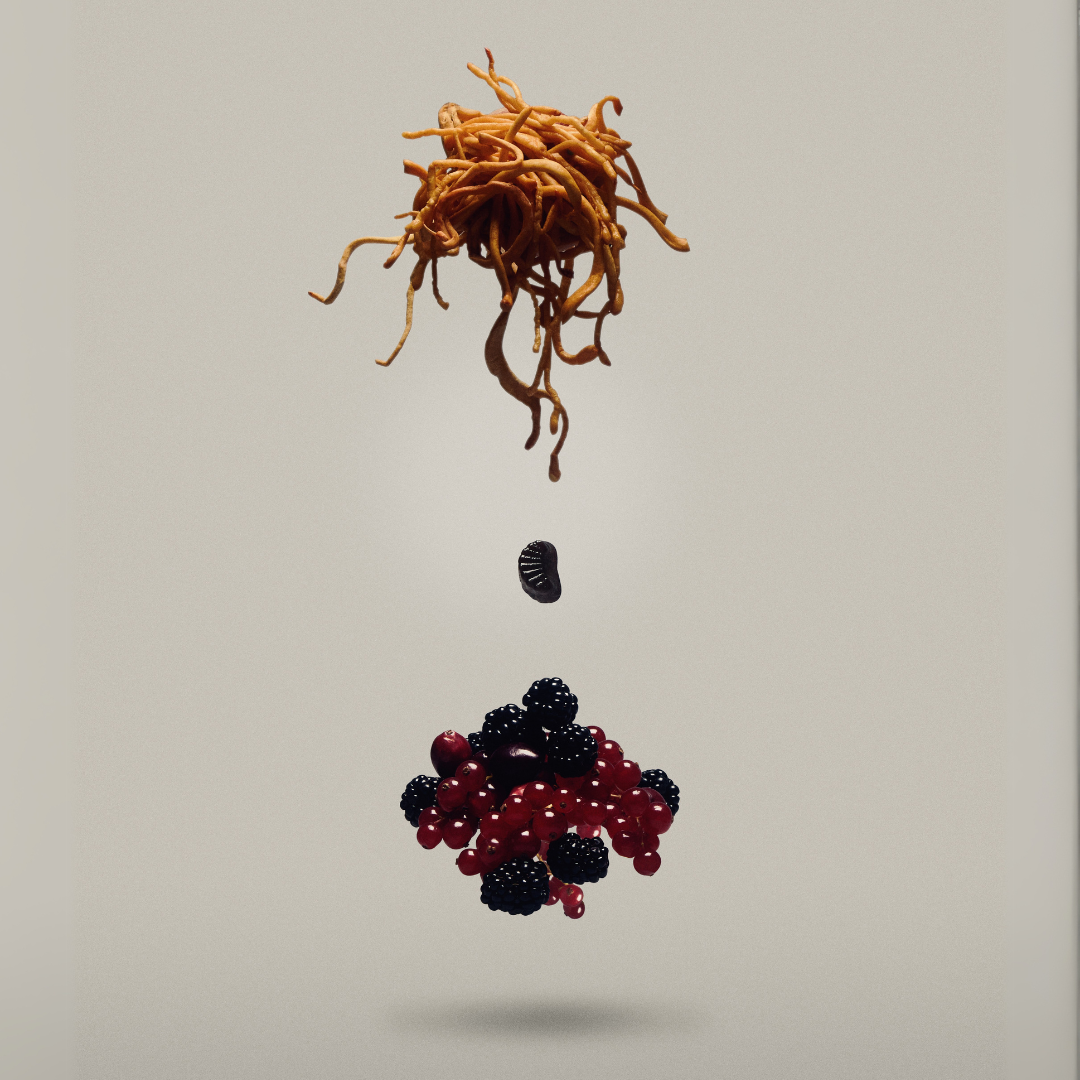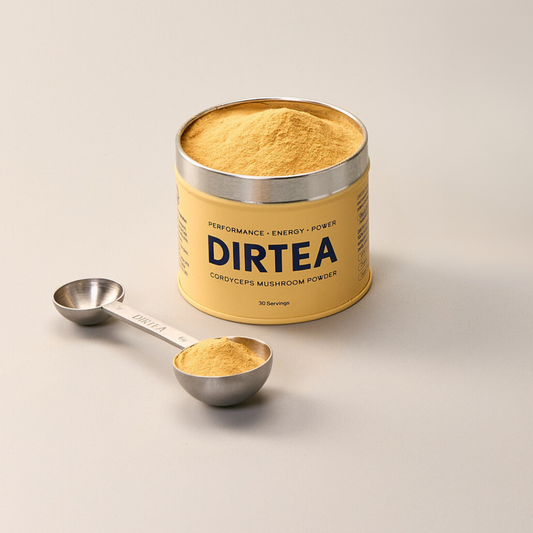A Guide to Cordyceps - The Performance Mushroom

Share
Introduction
Cordyceps is a fungus found all over the world. The name Cordyceps derives from the Ancient Greek word “kordkord\u00fyle” (club) and the Latin suffix "-ceps," meaning “headed.” Some of the rarest varieties are at higher altitudes in the Himalayan regions of China, Nepal, Tibet, and India. In total, there have been more than 750 species of Cordyceps identified. A lot of Cordyceps are parasitic in nature, which means they will spore onto living insects and infect them in order to grow. (This isn’t the Cordyceps we use!) Of the 750 different species, only 200 infect insects. This type of strain is known as Ophiocordyceps unilateralis sensu lato, which controls the behaviour of insects by manipulating their muscles.
Before we unveil a host of fun findings about these mushrooms, let's address the elephant in the room: Can Cordyceps turn humans into zombies? No! The HBO series, “The Last Of Us,” dramatized this idea, but the fungi lack the machinery to infect humans. The human body’s physiology and temperature render such infections impossible.
How Cordyceps Gained the World’s Attention
Cordyceps gained particular attention in the world of sports when the Chinese women’s track and field team broke multiple world records in the Chinese 1993 National Games. The Chinese women dominated the National Games, breaking the records for 1,500, 3,000 and 10,000 metre runs. The Chinese women’s coach Ma Junren refused to divulge the secret of his training; the following August, the Chinese women's team won every single-track distance event at the Stuttgart World Championships. These records caught the attention of the Olympics committee and speculation that they used performance-enhancing drugs. The rumours were proven wrong when their drugs tests reflected zero steroids. Ma Junren was known for using strange techniques and herbs, all of which were kept a secret.
After further questioning, he eventually explained that he had been using Cordyceps, a natural and legal fungi, also known as mother nature’s performance enhancer.
Cordyceps Militaris vs. Cordyceps Sinensis
Cordyceps Sinensis
For hundreds of years, nomadic herders in Tibet and Nepal have uncovered the potent Cordyceps Sinensis while grazing high-altitude lands. Observing livestock such as yaks and goats becoming stronger after consuming this mushroom, herders began using Cordyceps Sinensis powder to increase milk production and boost reproductive capacity. Its medicinal properties, including enhancing vitality and aphrodisiac effects, were later confirmed. Today, the rarity of this mushroom makes it highly valuable, sometimes reaching up to £16,000/kg, as documented in research on traditional uses and medicinal potential of Cordyceps Sinensis.
Cordyceps Militaris
Given the scarcity of Cordyceps Sinensis, researchers developed methods to cultivate Cordyceps Militaris in controlled environments. This cultivated strain uses rice grain as a base and boasts high levels of beneficial compounds. Studies highlight how it supports immune health and enhances physical performance, both in athletic and everyday contexts, as detailed in New Insights Into Cordycepin Production.
Cordyceps Militaris exhibits a chemical profile similar to Sinensis, with some advantages, such as significantly higher cordycepin content. Unlike the challenges of foraging in the Tibetan Plateau, this cultivated mushroom offers accessibility without compromising on efficacy. Its role in improving exercise tolerance has been underscored in studies, such as research on Cordyceps Militaris improving high-intensity exercise performance.
Cordycepin: The Key Compound
Although the two species of Cordyceps are very similar, Cordyceps Militaris contains up to 90 times more cordycepin than Cordyceps Sinensis.
But what is cordycepin?
Cordycepin is structurally similar to adenosine, which makes adenosine triphosphate (ATP), the molecule that powers your cells and is responsible for energy production. Although Cordyceps Sinensis (the naturally occurring strain) contains adenosine, it lacks cordycepin, unlike Cordyceps Militaris. Cordycepin was first isolated in 1950 from Cordyceps Militaris and the content found in this strain is far greater than that of Cordyceps Sinensis. Cordyceps Militaris also contains adenosine, Cordyceps polysaccharides, antioxidants, and flavonoids, all contributing to its reputation as a powerhouse mushroom.
The Benefits of Cordyceps
The Goodness Within
Beta-glucans are among the most vital polysaccharides found in functional mushrooms and are often cited for their potential to balance and support immune function. The beta-glucan concentration in Cordyceps contributes to the mushroom’s numerous potential effects on the immune system. Below are promising studies and insights into how the mushroom’s active compounds may positively interact with the body and improve immunity, energy, and libido. Although these studies provide insights, their findings may not always replicate in human contexts, as many are conducted on animals.
Pre-Workout Recovery
Cordyceps may improve exercise performance, which could be associated with an increase in the production of the molecule adenosine triphosphate (ATP). ATP is an important “energy molecule” found in all life forms. It is often referred to as the energy currency of the cell and can be compared to storing “energy” money in a bank. ATP may positively contribute to the way your body uses up oxygen and help you during training.
A 2016 study showed that a three-week supplementation period with Cordyceps Militaris resulted in significantly improved tolerance to high-intensity exercise, suggesting the potential for greater benefits with longer-term supplementation.
In another study, 37 healthy elderly adults were tested for the effects of Cordyceps on exercise capacity using stationary bikes. Participants who took 3 grams of Cordyceps per day for six weeks increased their VO2 max (a key measure of cardiorespiratory fitness) by 7%, while the placebo group showed no change.
Increased Energy
Cordyceps has been used for endurance and its potential support for energy levels in Traditional Chinese Medicine. Recent animal studies have shown the potential anti-fatigue activity of Cordyceps. Known to support energy production by helping oxygen flow through the body, it’s a firm favourite among those seeking a natural energy surge.
May Support Libido
Libido, or sex drive, is an essential aspect of well-being. Cordyceps has been used by both men and women in Asia for thousands of years to support sexual energy. Promising research suggests that Cordyceps Militaris may improve sexual performance and enhance aphrodisiac activity.
Enhanced Performance
Packed with Vitamin D and other energising properties, Cordyceps is nature’s performance enhancer. Its role in balancing sex hormones has made it increasingly popular among men and women looking to boost desire, stamina, and overall vitality.
How to Use Cordyceps
DIRTEA Cordyceps can be easily integrated into your daily routine and tailored to specific lifestyle goals. Here are some ways to use it effectively:
-
For Runners: Mix a teaspoon of DIRTEA Cordyceps powder into water or a pre-run smoothie to enhance stamina and oxygen utilization. Post-run, add it to a recovery drink to aid in muscle repair and reduce fatigue.
-
For Gym-Goers: Add Cordyceps to your pre-workout beverage to support ATP production and boost energy levels during high-intensity training sessions. Combine it with protein shakes post-workout to improve recovery.
-
For Busy Professionals: Stir Cordyceps into your morning coffee or tea for a sustained energy boost and improved focus throughout the day.
-
For Yoga and Meditation: Blend Cordyceps into herbal tea to enhance relaxation and mental clarity, supporting mindfulness practices.
For optimal results, consume it consistently as part of your wellness regimen. Adapt the timing and pairing of Cordyceps based on your personal activity and recovery needs.
FAQs About Cordyceps
What Do Cordyceps Taste Like?
Cordyceps extract powder has an earthy, nutty taste that mixes well with smoothies or juices. The powdered extract can also be mixed with hot water and tastes delicious on its own.
Can I Take Cordyceps Every Day?
Yes, Cordyceps is safe for daily use. Regular consumption enhances its benefits over time.
Are There Any Side Effects of Taking Cordyceps?
Cordyceps is generally well-tolerated, but individuals with specific medical conditions or allergies should consult a healthcare provider before use.
Why Choose DIRTEA Cordyceps?
DIRTEA Cordyceps products are crafted to ensure maximum potency and quality. From boosting energy to aiding recovery, DIRTEA Cordyceps is your trusted partner for achieving peak performance.
Key Facts About Cordyceps
-
Can be used pre-workout and for recovery.
-
May boost libido and energy levels.
-
Cordyceps Militaris is grown in controlled environments, ensuring higher cordycepin content than wild Cordyceps Sinensis.
Cordyceps Summary
Cordyceps is a versatile, powerful mushroom that supports energy, stamina, immune health, and more. Whether you’re looking to improve athletic performance or general well-being, DIRTEA Cordyceps offers a natural, effective solution. Explore our Cordyceps products and elevate your performance today.
References
- Olatunji, O.J., Tang, J., Tola, A., Auberon, F., Oluwaniyi O., Ouyang, Z,. (2018). ‘The Genus Cordyceps: An Extensive Review of its Traditional Uses, Phytochemistry and Pharmacology’. Fitoterapia. 129, pp.293-316. doi: 10.1016/j.fitote.2018.05.010.
- Fredericksen, A. M., Zhang, Y., Hazen, M. L., Loreto,R. G., Mangold, C. A., Chen, D.Z., and Hughes, D. P., (2017). ‘Three-Dimensional Visualization and a Deep-Learning Model Reveal Complex Fungal Parasite Networks in Behaviorally Manipulated Ants’, PNAS, 114 (47), pp.12590-12595, doi.org/10.1073/pnas.1711673114
- Panda, A.K., and Swain K.C. (2011). ‘Traditional Uses and Medicinal Potential of Cordyceps Sinensis of Sikkim’. J Ayurveda Integr Med. 2(1), pp.9-13. doi: 10.4103/0975-9476.78183.
- Yuan, J.P., Zhao, S.Y., Wang, J,H., Kuang, H,C., and Liu, (2008). ‘X. Distribution of Nucleosides and Nucleobases in Edible Fungi’. J Agric Food Chem. 56 (3), pp.809-15. doi: 10.1021/jf0719205. Epub
- Chamyuang, S., Owatworakit, A., and Honda, Y.(2019). ‘New Insights Into Cordycepin Production in Cordyceps Militaris and Applications’. Ann Transl Med, 7(Suppl 3):S78. doi: 10.21037/atm.2019.04.12
- Yuan, J.P., Zhao, S,Y., Wang, J.H., Kuang, H.C., and Liu, X.(2008). ‘Distribution of Nucleosides and Nucleobases in Edible Fungi’. J Agric Food Chem. 56(3), pp.809-15. doi: 10.1021/jf0719205.
- Hirsch, K.R., Smith-Ryan, A.E., Roelofs, E.J., Trexler, E.T., and Mock, M.G. (2017 ). ‘Cordyceps Militaris Improves Tolerance to High-Intensity Exercise After Acute and Chronic Supplementation’. J Diet Suppl. 14 (1), pp.42-53. doi: 10.1080/19390211.2016.1203386.
- Yi, X., Xi-zhen, H., and Jia-shi, Z. (2004). ‘Randomized Double-Blind Placebo-Controlled Clinical Trial and Assessment of Fermentation Product of Cordyceps Sinensis (Cs-4) in Enhancing Aerobic Capacity and Respiratory Function of the Healthy Elderly Volunteers’. Chin. J. Integr. Med. 10, 187–192, doi.org/10.1007/BF02836405
- Lin, B., and Li, S. ‘Cordyceps as an Herbal Drug’.(2011). ‘Herbal Medicine: Biomolecular and Clinical Aspects’. 2nd edition. In: Benzie IFF, Wachtel-Galor S, editors. Boca Raton (FL): CRC Press/Taylor & Francis; 2011. Chapter 5. Available from: https://www.ncbi.nlm.nih.gov/books/NBK92758/
- NHS Inform (2023). ‘Loss of Libido’ Available at: https://www.nhsinform.scot/illnesses-and-conditions/sexual-and-reproductive/loss-of-libido. (Accessed 3 July 2023)
- Nguyen, T.V., Chumnanpuen, P., Parunyakul, K., Srisuksai, K., and Fungfuang W. (2021). ‘A Study of the Aphrodisiac Properties of Cordyceps Militaris in Streptozotocin-Induced Diabetic Male Rats’. Vet World. 14 (2), pp537-544. doi: 10.14202/vetworld.2021.


